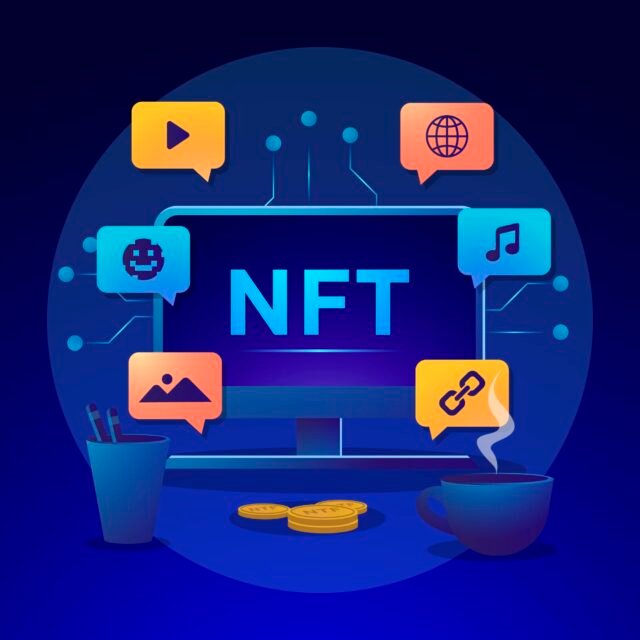NFTs, or Non-Fungible Tokens, have transformed the way people think about digital ownership and creativity. From digital art to virtual real estate, NFTs have created a new frontier where unique digital items hold real value. This blog explains what NFTs are and how they operate in simple terms.
What Is an NFT?
An NFT stands for Non-Fungible Token. “Non-fungible” means it cannot be exchanged one-for-one with something identical because it has unique properties. Unlike cryptocurrencies such as Bitcoin or Ethereum, which are fungible and interchangeable, each NFT has its own distinct identity.
Think of NFTs as digital certificates of ownership. When you buy an NFT, you get a proof of ownership for a specific digital asset. This asset can be artwork, music, videos, in-game items, or even tweets. NFTs live on blockchain technology, which ensures transparency and security.
How Does an NFT Work?
NFTs operate through blockchain, a decentralized digital ledger that records transactions in a secure and unchangeable way. The most common blockchain for NFTs is Ethereum, but other blockchains like Binance Smart Chain, Flow, and Solana also support NFTs. Effective nft software development plays a key role in building platforms and tools that enable minting, buying, and selling NFTs seamlessly on these blockchains.
The Role of Blockchain
When someone creates (or “mints”) an NFT, they create a new token on the blockchain that points to a digital item. This token contains metadata that includes details such as the creator, ownership history, and a link to the digital asset itself.
Because the blockchain is decentralized, no single entity controls the NFT. This transparency allows anyone to verify the authenticity and ownership of the NFT at any time.
Minting NFTs
Minting is the process of turning a digital file into an NFT. When an artist or creator mints an NFT, they upload their digital file to a platform and create a unique token on the blockchain. This action records the NFT on the blockchain and establishes it as a one-of-a-kind digital item.
After minting, the NFT can be bought, sold, or traded on various NFT marketplaces like OpenSea, Rarible, or Foundation.
Why Do People Buy NFTs?
People buy NFTs for several reasons. Some want to support artists and own unique pieces of digital art. Others see NFTs as collectibles, similar to rare baseball cards or vintage stamps. Gamers often purchase NFTs to gain access to special in-game items or characters.
Investors buy NFTs hoping the value will increase over time. Since each NFT is unique, its price depends on factors like rarity, creator reputation, and demand.
How To Buy and Sell NFTs
Buying and selling NFTs requires a digital wallet that supports cryptocurrency transactions, usually Ethereum. Here is how the process generally works:
Step 1: Set Up a Digital Wallet
You need a wallet like MetaMask or Trust Wallet to store cryptocurrency and NFTs. This wallet connects you to NFT marketplaces.
Step 2: Fund Your Wallet
Purchase cryptocurrency, typically Ethereum (ETH), through an exchange like Coinbase or Binance. Transfer the ETH to your digital wallet.
Step 3: Choose an NFT Marketplace
Platforms like OpenSea or Rarible list NFTs available for purchase. You can browse collections, view prices, and check ownership history.
Step 4: Buy the NFT
Once you find an NFT you want, place a bid or buy it outright if the price is fixed. After the transaction, the NFT transfers to your wallet.
Step 5: Selling NFTs
If you own an NFT, you can list it for sale on a marketplace. Set a price or auction format, and when someone buys it, the NFT transfers to their wallet and the payment goes to you.
NFT Use Cases Beyond Art
While NFTs gained fame in the art world, their use extends far beyond digital paintings and collectibles.
Gaming
NFTs give players ownership of in-game items, characters, or skins. Players can trade or sell these items, which hold value outside the game itself.
Music and Media
Musicians release NFTs to grant fans exclusive access to songs, albums, or concert tickets. Media companies use NFTs to sell digital collectibles like movie posters or clips.
Virtual Real Estate
Virtual worlds like Decentraland or The Sandbox let users buy, sell, and develop land parcels as NFTs. These digital plots can be used for advertising, events, or virtual business.
Identity and Certification
NFTs can store certificates, licenses, or diplomas securely on the blockchain. This ensures authenticity and prevents fraud.
Common Misconceptions About NFTs
Many people confuse NFTs with cryptocurrencies. NFTs do not function as currency but act as digital proof of ownership. Another myth is that NFTs only benefit wealthy investors. In reality, artists and creators from all backgrounds use NFTs to reach audiences and generate income. A skilled blockchain developer helps create the underlying infrastructure that makes these opportunities possible for everyone.
Environmental Concerns and Solutions
NFTs, especially those on Ethereum, have faced criticism for high energy consumption due to the blockchain’s proof-of-work mechanism. However, many blockchains are shifting to proof-of-stake, which significantly reduces energy use.
Several NFT platforms also commit to offsetting carbon emissions or support eco-friendly blockchains to minimize environmental impact.
The Future of NFTs
NFT technology continues to evolve and find new applications. As blockchain networks improve and adoption grows, NFTs might become a standard way to manage digital ownership, contracts, and creative content.
Companies are exploring NFTs for loyalty programs, ticketing systems, and more, showing that this technology has broad potential beyond collectibles.
Conclusion
NFTs offer a new way to own and trade digital assets securely using blockchain technology. By providing a unique digital identity to items like art, music, and virtual goods, NFTs change how creators monetize their work and how users engage with digital content.
Whether you want to collect digital art, participate in virtual worlds, or support your favorite artists, NFTs open up a world of possibilities powered by blockchain.







